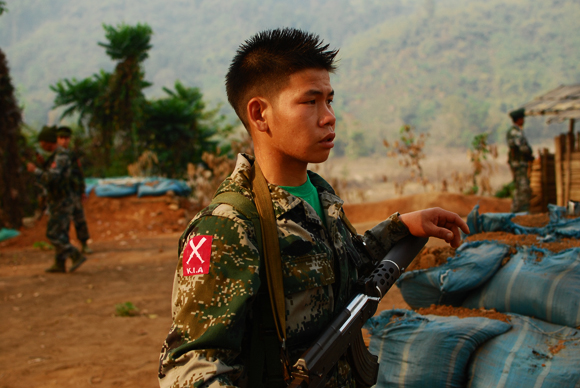MAE SOT, Thailand — On June 9, deadly clashes broke out in northern Myanmar between the country’s army and the ethnic minority Kachin Independence Army (KIA). The fighting reportedly erupted after Myanmar’s military moved to secure the Tarpein Hydropower Project, a Chinese-built dam that came online in January. The plant, which sits on a tributary of the Irrawaddy River close to rebel-held areas, has since suspended its operations, and the clashes have spread to surrounding regions, pushing Myanmar’s strategic borderlands to the brink of civil war.
Rights activists say the Myanmar army’s offensive has brought a range of rights abuses, from the press-ganging of civilians into work as military porters to the abuse of women and young girls. More than 10,000 civilians have since sought refuge along the Myanmar-China border as leaders from both sides begin tentative cease-fire talks.
The current skirmish is the latest in a string of clashes along Myanmar’s troubled periphery, all linked to a junta plan to incorporate ethnic groups that had signed cease-fire agreements into a unified Border Guard Force (BGF) ahead of last November’s election. In August 2009, tensions over the BGF plan also exploded into open clashes in the Kokang Special Region of Shan state, sending 30,000 refugees fleeing over the Chinese border and greatly riling China’s leadership. Since the election, fighting has also erupted across Karen state to the south and in other parts of Shan state.
The 4,000-strong KIA, which signed a cease-fire agreement in 1994, flatly refused to join the BGF, which would require it to submit to central government control. As a result, Kachin parties were blocked from running candidates in November’s elections, and the state-run media began referring to the KIA as “insurgents,” a designation not used since the cease-fire.

A KIA soldier mans the frontlines close to Laiza, Kachin State, on March 30, 2012. (Sebastian Strangio)
The skirmishes in Kachin state are also closely intertwined with Chinese interests in the region, where Beijing is building a series of hydropower dams that have stoked local resentment and become a focus of longstanding grievances.
“It’s just exacerbated a feeling among Kachin communities that they’re being sidelined by all this, that they’re getting nothing out of it,” said David Mathieson, Myanmar researcher for Human Rights Watch. “All that power’s just going to be pumped back into China, and they’re the ones being displaced. They’re the ones whose farmland is being flooded.” In May, the Kachin Independence Organization (KIO), the KIA’s political wing, wrote to Beijing to register its objections to dams under construction in northern Myanmar, warning of “civil war” if its concerns were not addressed.
For its part, Naypyidaw’s state-run media accuses the KIA of “degrad[ing] the image of their country” by creating “hindrances” to Chinese investment.
The Kachin conflict epitomizes China’s key dilemma in dealing with its wayward southern neighbor: how to balance its growing investments in northern Myanmar with its fears that the region will be engulfed by ethnic turmoil. As a result, China has become increasingly frustrated with Naypyidaw’s inability to keep its own backyard in order.
In a briefing released last September, the International Crisis Group (ICG) wrote (.pdf) that the Kokang conflict had “dramatically changed China’s view” of Myanmar’s ethnic groups. Previously, China saw them as buffers that could be played off against Naypyidaw for strategic gain. After it became apparent that Myanmar was willing to use force to root out recalcitrant armed groups, Beijing began to see minority groups as a liability and potential source of instability. Myanmar’s leaders, too, began to seem “less trustworthy and capable of unpredictable behavior.”
Even before then, China’s patience was wearing thin. A leaked diplomatic cable from the U.S. Embassy in Yangon, dated Jan. 18, 2008, cited Chinese Ambassador Guan Mu as admitting that a future pro-democracy uprising or related turmoil would impact Chinese business interests in Myanmar. “The Chinese can no longer rely on the generals to protect their interests here, and recognize the need to broker some solution that keeps the peace, including bringing in the pro-democracy supporters,” the cable stated.
“I think they’re consistently exasperated by the stupidity exhibited by Naypyidaw,” Mathieson said of China’s leaders. “They’re constantly trying to push [Naypyidaw] to a more practical approach.”
In the recent string of ethnic conflicts, this has translated to a greater willingness by China to take the lead in bringing all sides to the table. Chinese-brokered talks were held last year between military leaders and figures including Bao Youxiang, the reclusive leader of the United Wa State Authority, another cease-fire group that has rejected the BGF plan. According to the ICG briefing, China also brokered “at least” 13 rounds of negotiations between the KIO and the government between April 2009 and April 2010. Last month, the KIO called on China to mediate the current conflict. So far, Beijing has called for both sides to exercise “restraint.”
Mathieson said the Chinese, while not “altruistic” in their approach to the situation, could help bring about a resolution to the fighting. “It’s well within their interests to avoid conflict and settle things peacefully,” he said.
However, a durable solution in the borderlands — as opposed to a temporary cease-fire — would have to overcome decades of entrenched ethnic suspicions and the junta’s myopic view of its minority “problem.” Mark Farmaner, the spokesman for Burma Campaign U.K., said the fighting showed that there has been little change in the Myanmar government’s attitudes toward its ethnic minorities despite last year’s election and the much-heralded transition to a new “civilian” government.
“The new constitution denies ethnic rights, protection and any level of autonomy, and also outlaws armed ethnic groups,” he said. “It was always obvious that the ethnic groups would refuse to give up their arms without achieving their political objectives, and [that] the dictatorship would then use military force to attempt to force their submission.”
Whether Beijing can backstop a long-lasting and just peace in the borderlands, rather than pursue a narrow conception of its own economic and security interests, remains an open question. But without a change of heart from Naypyidaw, Myanmar seems set to take yet another tragic turn.



